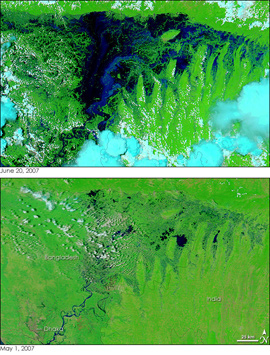Flooding in India Leaves 3.5 million Homeless
By Joshua S Hill
September 11, 2007
|
|
The Indian military has been evacuating thousands of people from Assam, a state in northeastern India, after Monsoon rains flooded rivers. So far, 3.5 million people have been directly affected by the floods, in a state of 27 million. A total of 2,000 villages have been completely submerged by the floods, in some of the worst flooding in years.
The floods, which have sporadically affected the area since July of 2007, have also reached Bangladesh, and forced around a million people from their homes, and left thousands stranded. In the adjoining state to Assam, Manipur, at least 55,000 people have been left homeless and are sheltering in more than 30 relief camps.
 By June 20, 2007, the summer’s first floods had engulfed northeastern Bangladesh. Monsoon rains routinely flood the low-lying country in the summer, though some years are worse than others. This image, captured by the Moderate Resolution Imaging Spectroradiometer (MODIS) on NASA’s Aqua satellite, is centered on the northeast administrative region, Sylhet. Water, dark blue and black in the false-color image, covers most of the region. The floods destroyed several villages, trapped thousands of families, and forced thousands of evacuations, reported the Gulf Times on June 20. NASA images courtesy the MODIS Rapid Response Team at NASA GSFC. |
Since the floods began, officials have announced that approximately 850 people have died in Bangladesh alone.
“The situation is grim,” the chief minister of tea- and oil-rich Assam state, Tarun Gogoi, told Reuters on Tuesday.
3 million people from Assam are currently living in temporary shelters, government buildings, and local schools. So far, the tally for Assam dead sits at 50.
Landslides and flooding have blocked many highways, including links to the tiny border state of Sikkim, and have stranded trucks delivering essential foodstuffs and medicine, subsequently forcing the price of such essentials to rise dramatically.